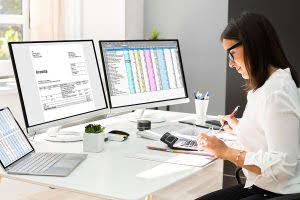Balance Sheet Formula Assets = Liabilities + Equity

The showroom receives a brand new vehicle on 5 January 2021 and agrees to pay the car manufacturer’s entire sum in 3 months. In the meantime, the showroom is allowed to sell the new vehicle. You cannot recognize a future asset now based on the expectation of a transaction or event that hasn’t already happened. The business has acquired control of the asset due to a past transaction or event. All programs require the completion of a brief online enrollment form before payment.
- Likewise, its liabilities may include short-term obligations such as accounts payable and wages payable, or long-term liabilities such as bank loans and other debt obligations.
- This financial statement lists everything a company owns and all of its debt.
- Balance sheets can be used with other important financial statements to conduct fundamental analysis or calculate financial ratios.
- The difference between the $400 income and $250 cost of sales represents a profit of $150.
- Because profits are generated for the shareholders, retained earnings is theoretically due to the business owners.
Shareholder Equity
- Financial analysis often involves both using or analyzing historic information and forecasting forward-looking financial statements.
- Along with Equity, they make up the other side of the Accounting Equation.
- Changes in any one or all of these components will change the Accounting Equation.
- Its liabilities (specifically, the long-term debt account) will also increase by $4,000, balancing the two sides of the equation.
- For a more specific breakdown of the components of equity, use the expanded equation instead.
Ltd has below balance sheet for 5 years, i.e., from the year 2014 to 2018. The most liquid asset is cash itself, while non-liquid assets include things such as real estate, machinery, or land because they https://www.bookstime.com/ cannot be converted quickly to cash. How quickly an asset can be converted to cash or a cash equivalent is a term called liquidity. Being an inherently negative term, Michael is not thrilled with this description.
Examples
A company will be able to quickly assess whether it has borrowed too much money, whether the assets it owns are not liquid enough, or whether it has enough cash on hand to meet current demands. The https://www.facebook.com/BooksTimeInc/ accounting equation is often expressed as an accounting formula and states that the sum of liabilities and equity is always equivalent to the total assets of the organization. It is the fundamental foundation of accounting that ensures financial statement accuracy. The accounting equation states that a company’s total assets are equal to the sum of its liabilities and its shareholders’ equity.

Which of these is most important for your financial advisor to have?
- You cannot recognize a future asset now based on the expectation of a transaction or event that hasn’t already happened.
- In this example, the owner’s value in the assets is $100, representing the company’s equity.
- The process of recording these transactions will continue across the period.
- He is a CFA charterholder as well as holding FINRA Series 7, 55 & 63 licenses.
While the financial landscape continues to evolve and undergo dynamic changes, a key foundational element that continues to guide accounting processes across industries is the accounting equation. Acting as the cornerstone for financial statements, it holds the key in enabling us to understand the financial health of an organization. The balance between assets, liability, and equity makes sense when applied to a more straightforward example, such as buying a car for $10,000. In this case, you might use a $5,000 loan (debt), and $5,000 cash (equity) to purchase it. Your assets are worth $10,000 total, while your debt is $5,000 and equity is $5,000.

The difference between the revenue and profit generated and expenses and losses incurred reflects the effect of net income (NI) on stockholders’ equity. Overall, then, the expanded accounting equation is useful in identifying at a basic level how stockholders’ equity in a firm changes from period to period. If the left side of the accounting equation (total assets) increases or decreases, the right side (liabilities and equity) also changes in the same direction to balance the equation. Since the balance sheet is founded on the principles of the accounting equation, this equation can also be said to be responsible for estimating the net worth of an entire company.

Where are assets recorded?

An asset is a resource, controlled by the business, that is expected to provide benefits in the future. Common examples include inventory, account receivables and PP&E (property, plant and equipment). If the net amount is a negative amount, it is referred to as a net loss. Balance sheets are one of the primary statements used to determine the net worth of a company and get a quick overview of it’s financial health. The ability to read and understand a balance sheet is a crucial skill for anyone involved in business, but it’s one that many people lack. As transactions occur within a business, assets equals the amounts of assets, liabilities, and owner’s equity change.
Every transaction is recorded twice so that the debit is balanced by a credit. A company’s quarterly and annual reports are basically derived directly from the accounting equations used in bookkeeping practices. These equations, entered in a business’s general ledger, will provide the material that eventually makes up the foundation of a business’s financial statements.
What Is the Accounting Equation?
- The assets are the operational side of the company, basically a list of what the company owns.
- Shareholder equity is not directly related to a company’s market capitalization.
- In our examples below, we show how a given transaction affects the accounting equation.
- For small privately-held businesses, the balance sheet might be prepared by the owner or by a company bookkeeper.
- So whatever the worth of assets and liabilities of a business are, the owners’ equity will always be the remaining amount (total assets MINUS total liabilities) that keeps the accounting equation in balance.
For example, when a company borrows money from a bank, the company’s assets will increase and its liabilities will increase by the same amount. When a company purchases inventory for cash, one asset will increase and one asset will decrease. Because there are two or more accounts affected by every transaction, the accounting system is referred to as the double-entry accounting or bookkeeping system.
What Are the 3 Elements of the Accounting Equation?
Our goal is to deliver the most understandable and comprehensive explanations of financial topics using simple writing complemented by helpful graphics and animation videos. 11 Financial is a registered investment adviser located in Lufkin, Texas. 11 Financial may only transact business in those states in which it is registered, or qualifies for an exemption or exclusion from registration requirements. 11 Financial’s website is limited to the dissemination of general information pertaining to its advisory services, together with access to additional investment-related information, publications, and links. Changes in any one or all of these components will change the Accounting Equation.

